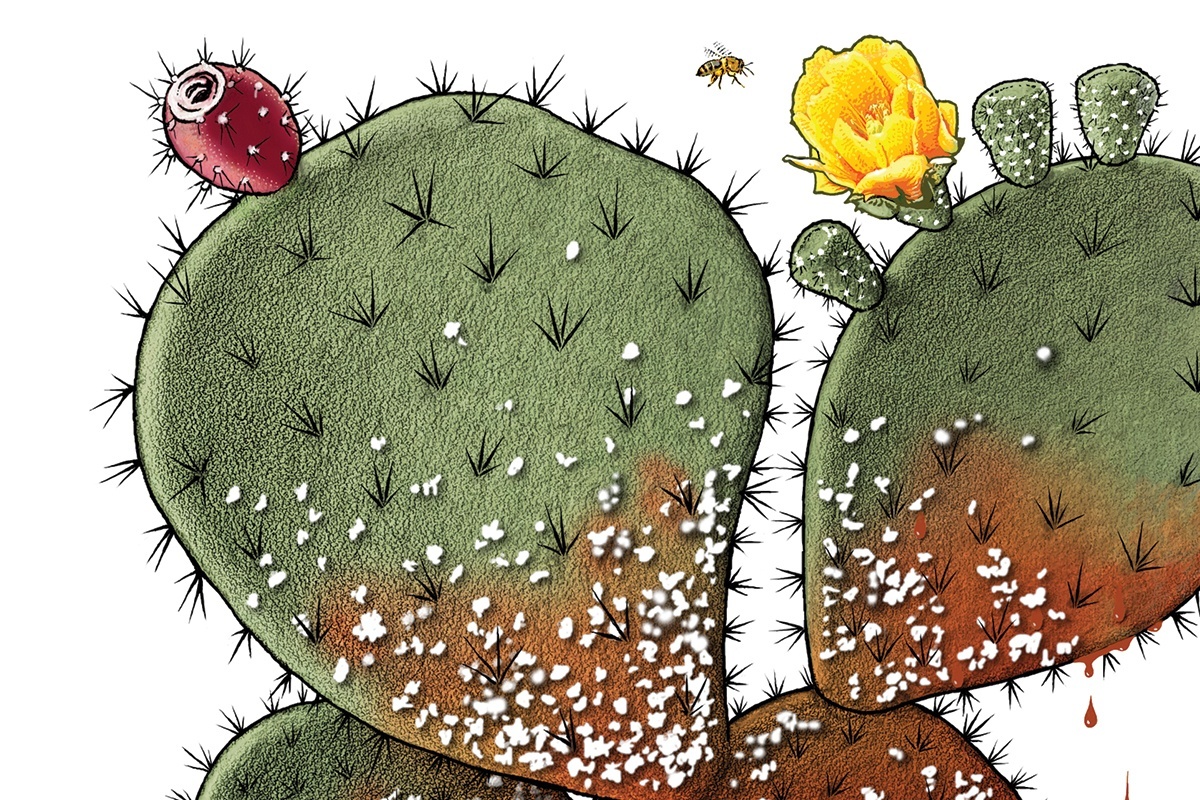Red lips, red flags, red lights, red dresses, red sports cars.
The color catches our eye, accelerates our heartbeat and quickens our breath. It’s the color of power, passion and excitement—and for centuries, a tiny insect that thrives in Texas, the American southwest and Mexico has produced the brightest, clearest reds. Extract from cochineal insects still colors foods, cosmetics and clothing throughout the world.
Before the Texas Revolution, Col. Juan Almonte noted that the cochineal crop, gathered twice yearly in Texas, was hauled to Laredo and shipped to agents of the British crown. They needed it to color their red coats. When the Lone Star flag was adopted in 1839, the red field was dyed with cochineals.
Cochineals belong to the scale family. The parasitic bugs are about one-third the size of a ladybug and feed on the spiny pads of prickly pear cactuses. A glance will tell you if cochineals have infested a cactus:
The pads are covered with bits of white fluff. Females possess carminic acid, which is distasteful to ants and grubs that might otherwise find them delicious. It is also what creates her carmine, or red pigment.
Even though the insect appears white, crushing the female cochineal releases the dark red liquid. Aztecs discovered this and already were doing a land-office business in cochineals when Spain claimed the New World. Spanish ships soon carried dried cochineals to Europe alongside plundered silver and gold. Cochineal created more intense and permanent color than any previously known red pigments, so the dye was immediately in demand for silks, velvets and tapestries.
According to Amy Butler Greenfield, author of A Perfect Red, artists Titian, Rubens, Van Dyck, Rembrandt and Van Gogh adopted cochineal red. As Mexicans skillfully cultivated the insects, they developed a new species, Dactylopius coccus, which was twice the size of wild cochineals and more profitable. In addition to producing striking scarlets and crimsons, cochineal also could be formulated to create shades of soft pink and rose that resisted fading.
Europeans also used cochineal powder to make cosmetics to stain their lips and cheeks. The vivid reds created an outstanding contrast to their pale faces, which they whitened with lead powder. Along the way, medical uses became popular, and apothecaries concocted their own secret formulas, which they touted as antidepressants.
In spite of the best efforts of pirates who tried to steal cochineals and establish farms in Europe, the temperamental little bug resisted transfer to new climes. Collected specimens died in cold, rain, heat and other environmental changes, as did the cactuses on which they thrived. A few of these early industrial pirates lost fortunes when their entire stolen crop of cochineal-infested cactus rotted in the holds of ships during the voyage to Europe.
When bright aniline dyes made from coal tar were developed in the 1850s and ’60s, the cochineal industry took a hit. Today, the use of cochineals is approved by the Food and Drug Administration to produce a natural red color for fruit juices, gelatins, candies, shampoos, cosmetics, yogurt, maraschino cherries, popsicles, and even pink tequila and lemonade. Read the label. Does it say cochineal, carmine, carminic acid or Natural Red 4? Any way you say it, that means bug red.
Martha Deeringer, a member of Heart of Texas EC, lives near McGregor.


